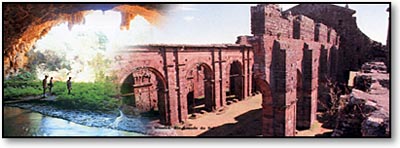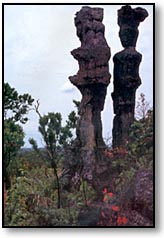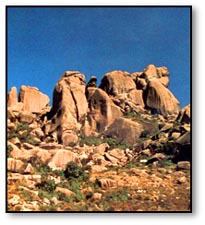
History
|
The
Portuguese were the first European settlers to arrive in the area,
led by adventurous Pedro Cabral, who began the colonial period in 1500.
The Portuguese reportedly found native Indians numbering around seven
million. Most tribes were peripatetic, with only limited agriculture
and temporary dwellings, although villages often had as many as 5000
inhabitants. Cultural life appears to have been richly developed, although
both tribal warfare and cannibalism were ubiquitous. The few remaining
traces of Brazil's Indian tribes reveal little of their lifestyle,
unlike the evidence from other Andean tribes. Today, fewer than 200,000
of Brazil's indigenous people survive, most of whom inhabit the jungle
areas.
Other Portuguese explorers followed Cabral, in search of valuable goods
for European trade but also for unsettled land and the opportunity
to escape poverty in Portugal
itself. The only item of value they discovered was the pau do brasil
(brazil wood tree) from which they created red dye. Unlike the colonizing philosophy
of the Spanish, the Portuguese in Brazil were much less focused at first on conquering,
controlling, and developing the country. Most were impoverished
sailors, who were far more interested in profitable trade and subsistence agriculture
than in territorial expansion. The country's interior remained unexplored.
impoverished
sailors, who were far more interested in profitable trade and subsistence agriculture
than in territorial expansion. The country's interior remained unexplored.
Nonetheless, sugar soon came to Brazil, and with it came imported slaves. To
a degree unequaled in most of the American colonies, the Portuguese settlers
frequently intermarried with both the Indians and the African slaves, and there
were also mixed marriages between the Africans and Indians. As a result, Brazil's
population is intermingled to a degree that is unseen elsewhere. Most Brazilians
possess some combination of European, African, Amerindian, Asian, and Middle
Eastern lineage,and this multiplicity of cultural legacies is a notable feature
of current Brazilian culture.
The move to open the country's interior coincided with the discovery in
the 1690s of gold in the south-central part of the country. The country's
gold deposits
didn't pan out, however, and by the close of the 18th century the country's focus
had returned to the coastal agricultural regions. In 1807, as Napoleon Bonaparte
closed in on Portugal's capital city of Lisbon, the Prince Regent shipped himself
off to Brazil. Once there, Dom Joao established the colony as the capital of
his empire. By 1821 things in Europe had cooled down sufficiently that Dom Joao
could return to Lisbon, and he left his son Dom Pedro I in charge
of Brazil. When the king attempted the following year to return Brazil to subordinate
status as a colony, Dom Pedro flourished his sword and declared the country's
independence from Portugal (and his own independence from his father).
In the 19th century coffee took the place of sugar as Brazil's most important
product. The boom in coffee production brought a wave of almost one million European
immigrants, mostly Italians, and also brought about the Brazilian republic. In
1889, the wealthy coffee magnates backed a military coup, the emperor fled, and
Brazil was no more an imperial country. The coffee planters virtually owned the
country and the government for the next thirty years, until the worldwide depression
evaporated coffee demand. For the next half century Brazil struggled with governmental
instability, military coups, and a fragile economy. In 1989, the country enjoyed
its first democratic election in almost three decades. Unfortunately, the Brazilians
made the mistake of electing Fernando Collor de Mello. Mello's corruption did
nothing to help the economy, but his peaceful removal from office indicated at
least that the country's political and governmental structures are stable.
 Brazil
has the sixth largest population in the world--about 148 million people--which
has doubled in the past 30 years. Because of its size, there are
only 15 people per sq. km, concentrated mainly along the coast and in the
major cities, where two-thirds of the people now live: over 19 million
in greater Sao Paulo and 10 million in greater Rio.
Brazil
has the sixth largest population in the world--about 148 million people--which
has doubled in the past 30 years. Because of its size, there are
only 15 people per sq. km, concentrated mainly along the coast and in the
major cities, where two-thirds of the people now live: over 19 million
in greater Sao Paulo and 10 million in greater Rio.
The immigrant Portuguese language was greatly influenced by the numerous
Indian and African dialects they encountered, but it remains the dominant
language in
Brazil today. In fact, the Brazilian dialect has become the dominant influence
in the development of the Portuguese language, for the simple reason that Brazil
has 15 times the population of Portugal and a much more dynamic linguistic environment.
 .
.